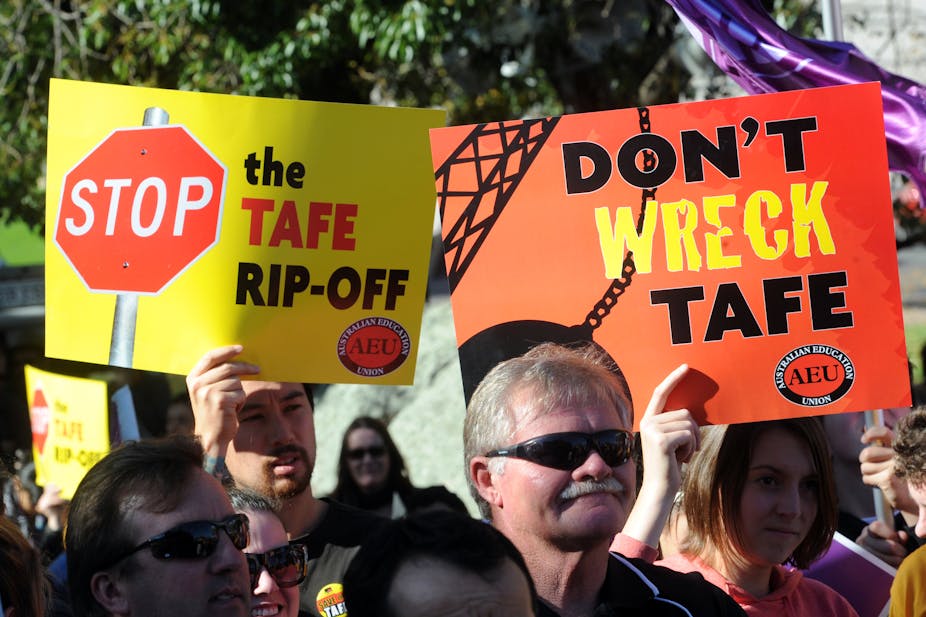The phrase “class warfare” has been thrown around a lot in the media and within political circles recently – usually without much basis.
But in Victoria it is very real; the current Liberal Government has declared open class warfare on the state’s workers through the drastic downsizing of publicly funded TAFE institutes.
TAFE in Victoria has a historical and visceral link to the education of working people. But it is under attack because the state government has gone for what they think is a soft target. After all, those who rely most on publicly funded vocational education are those who have minimal access to government or mainstream media to protest the changes.
TAFE groups are vigorously campaigning against the changes, but you can imagine if higher education was treated in the same way, there would be nationwide outrage. Meanwhile, the human impact of these changes will last well beyond the next electoral cycle.
The wrong changes
In its most recent budget the Victorian Government set aside $1.2 billion for vocational education and training (VET) needs and introduced a range of new fee-setting conditions to control a projected funding blowout of $400 million.
In addition to the fee changes they decided to remove the $170 million Full Service Provider payment to TAFE institutes, used for meeting an essential range of student service requirements.
The new funding model has been openly engineered to reduce the size of the sector and contribute to a budget surplus at the educational cost of Victoria’s working people. With course closures being announced across the sector it is unlikely the full $1.2 billion will ever be spent. This is at a time when investment in vocational education is crucial.
But this is not solely down to a Liberal government. The disappointing truth is this tactical retreat from publicly funded vocational education began with the previous Labor government.
Building communities
TAFE institutes and those that preceded them have always had a special position in Australian society, building the capacity of people and their communities. Often many students are those requiring more than one chance to find their way through post-secondary education.
There are dozens of TAFE teachers with stories about students who left school at Year 9 but enrolled in the TAFE system to seek a better life with better qualifications. But making further education for early school leavers more expensive, threatens to disengage those who left school undereducated and unqualified. This can only mean greater unemployment and social exclusion.
It is the real community capability building of TAFE that is lost in the economic ideology of the current and previous policies. Financial graphs, pie charts, and tables of numbers do not measure or promote the social mission that is an inseparable part of TAFE identity.
A right to public education
It will now be hard to define TAFE as public education given up to 70% of operational costs will be paid directly by students. People’s rights to well-funded public education have been forgotten to initiate an ideologically constructed user pays market.
In no way is this a strategy to drive education with social benefit.
The attractiveness of affordable fees and concessions has always drawn those from low socio-economic backgrounds to TAFE. There they have been supported by a range of services that include language and literacy classes, councillors, libraries and learning support.
The $170 million Full Service Provider funding underpinned these services. To retain any reasonable array of student services TAFE institutes will have to pass that cost onto students, further pushing up fees in 2013.
A user pays system is only effective if the user can afford to pay, concession rates in the new fee model are in some cases almost the same as current non-discounted fees and no concessions are available for Diploma or Advanced Diploma qualifications.
Students enrolled in those higher qualifications can access deferred fee payment through VET-Fee-Help, but lower level qualifications are ineligible.
Prisons or schools?
The current political direction, pursued through successive governments shows a preference for building prisons over building communities. Good education policy is left behind, while a desalinisation plant sits idle. These are the places where real investment of public money has been wasted.
To continue to offer accessible vocational education to the workers of Victoria the Victorian TAFE system requires rescue from four years of ill planned policy, not brutal and disruptive change.
Attacking the education institutes of the workers may well backfire as the tens of thousands of people that use TAFE each year and their families remember and take their dissatisfaction to the polls.

